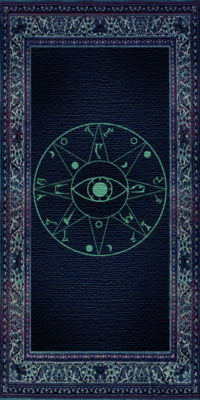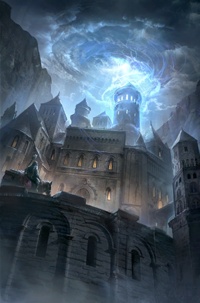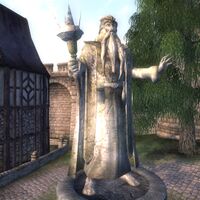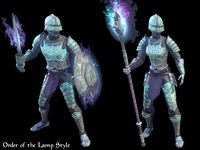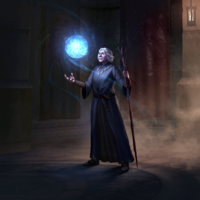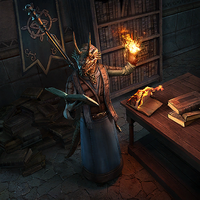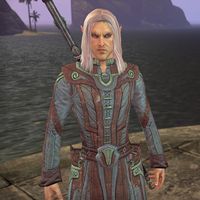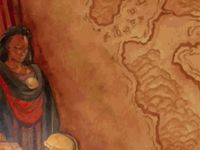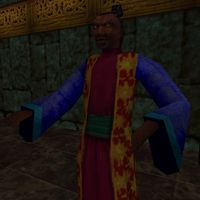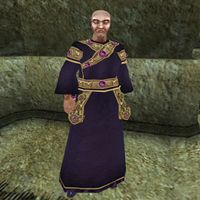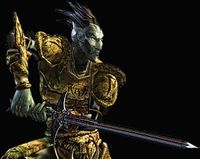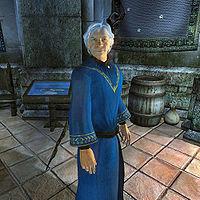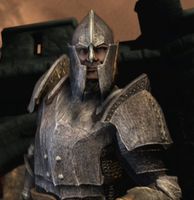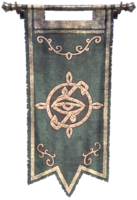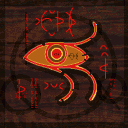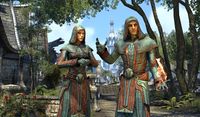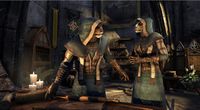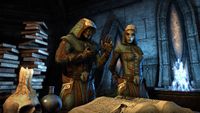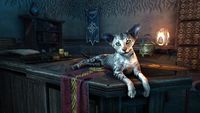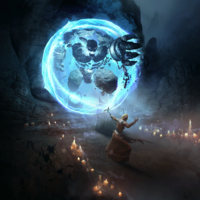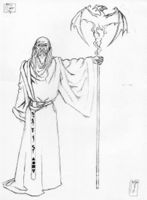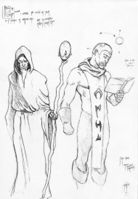Lore:Mages Guild
The Mages Guild, also known as the Guild of Mages, was a professional organization, once located throughout Tamriel, that was dedicated to the study and application of magicka and alchemy. The Aurbic Eye is the official symbol of the Guild.
The Mages Guild was led by an Arch-Mage, and guided by the Council of Mages, made up of six Archmagisters (one of them the Arch-Mage). By the Third Era, the Arch-Mage and the Council of Mages were headquartered at the guild's Arcane University in the Imperial City. The Council decided important Guild policies, such as its policy on the use of Necromancy and also administered recruitment, sale of spells in each local Guild Hall, and the enforcement of Guild law. The rules of the Guild varied from location to location, some differences more drastic than others. In addition, Guild Halls existed in most cities in Tamriel, each of which was run by a local Guild Magister (alternatively known as a Hall Magister). Below him were the Master of Incunabula (alternatively called the High Incunabulist)[1] and the Master at Arms. The Master of Incunabula had a counsel of two, the Master of Academia and the Master of the Scrye. The Master at Arms also had a counsel, the Master of Initiates and the Palatinus (the leader of the local chapter of the Order of the Lamp).[2]
Its charter from the Emperor specified that the guild must provide magic services to the public. Anyone could purchase potions, alchemical ingredients, magical items, and a selection of standard spells from the guild. However, training, goods, and services were cheaper for members, and the guild stewards were sometimes able to provide members with work. Furthermore, exclusive services such as spellmaking and enchanting, deemed potentially dangerous to the public at large, were only made available to higher-ranked guild members in good standing.[3][4] The guild also has rules about fraternization and lewd advances.[5]
The Mages Guild were Tamriel's leading archaeologists. They also were known for their interest in collecting a variety of artifacts such the Guardian's Eye, and they would be willing to kill to get their hands on them.[6] A tale speaks of a Mages Guild branch stealing an artifact (either Chrysamere, the Staff of Magnus, the Necromancer's Amulet, or the Warlock's Ring) from the great-grandfather of a secluded wizard.[7]
Before its disbandment, the Mages Guild offered instant transportation between their main halls for a small fee. This service was available to members and non-members alike, though members are generally given a significant discount.[8] It also had a subsidiary known as the Travelers League, which was only available to high ranking members and could teleport someone from anywhere in the world. This group were present in the Iliac Bay during the fifth century of the Third Era.[9]
History[edit]
Second Era[edit]
The Mages Guild was founded by Vanus Galerion circa 2E 230[3][10]:6[UOL 1] as a way of centralizing magic and thus moving away from the many separate groups (like the Psijic Order of which Galerion was a member) that had dominated the study of magic until that time. In fact, the Psijic Order had already been falling out of grace with society. Its policy of isolationism led to mistrust, and its religion (best described as a type of ancestor worship) was an increasingly unfashionable philosophy by the Second Era. With the formation of the Mages Guild, Galerion spread knowledge of the magical arts to the layman, selling magical items, potions, and scrolls to the general populace. As such, magic was no longer restricted to the aristocracy or intelligentsia.[2] Galerion named the office of the high guildmaster the Arch-Mage in memory of Shalidor, the first recorded mage to claim the title.[11]
The idea of Mages, Sorcerers, and assorted Mystics pooling their resources for the purpose of research and public charity was a revolutionary concept in the early Second Era. Galerion sought to prove the benefit of spellcasters working in close proximity, not for a mighty ritual, but for study, experimentation, and a sense of camaraderie. Thus, Galerion received the animosity of all. Operating out of Firsthold, Galerion was brought before his former mentor, Iachesis, the King of Firsthold, Rilis XII, and other notable nobles and members of the Psijic Order in the "Charter Conclave" of 2E 230 to state the intentions of the fraternity he was forming.[12][1] This meeting was the consequence of a fearful commonfolk, who had urged their king to settle the issue of "Galerion's Folly" (as it was known at the time). Kinlord Rilis instead saw in it a way to play both sides against each other. While Galerion's speech was not recorded for posterity (creating much scholarly interest into what lies and persuasions Galerion must have used), the charter was approved.[2] Some posit that Rilis approved the charter merely to further his own ends, but can be considered a sort of co-founder to the Mages Guild, despite his later pacts with Daedra and sadistic tendencies. Before his cruelty became well-known, the common folk would believe that the Kinlord had made a deal with "dangerous mages", a misconception the Guild hastily sought to rectify.[1] The Guild Act of 2E 321 further confirmed the Mages Guild and sanctioned its presence within the Second Empire.[3][13]
Immediately following the formation of the Guild, the question of security had to be addressed. Initially hiring guards, Galerion realized what the Tamrielic nobility had known for centuries; that money alone did not buy loyalty. To this end, Galerion formed the knightly Order of the Lamp.[2] The signing of the Guild Act also allowed for a greater diffusion of knowledge about exotic materials. The Mages Guild in particular are credited for learning how to refine magical ores that can surpass even ebony as a result.[14]
Rise to Prominence[edit]
In the following years, the Mages Guild grew across the Summerset Isle and gradually set foot in mainland Tamriel. Many superstitious and fearful rulers outlawed the Guild from their lands, but their descendants soon realized the benefits of allowing the Guild free rein in their territory. The Mages Guild had grown to be a powerful force within Tamriel, a dangerous foe if a somewhat disinterested ally. While the Mages Guild strove to maintain its neutrality in political conflicts, on rare occasions its participation has been the ultimate decider.[2] It was a positive for the Bretons, who are known for their innate magical ability. Urban Bretons in particular systematically organized themselves alongside the hierarchy the Mages Guild, and their children were tested for their magical potential at an early age, and those who passed entered apprenticeship programs funded by the Mages Guild or independent sponsorships.[15] A notable Breton alumni is Gyron Vardengroet who discovered the secret to immortality through alchemy, though he surpassed what the Mages Guild could offer.[16]
As only Altmer were permitted to be on the Summerset Isle, Mages Guild halls there consisted of only High Elves until Queen Ayrenn opened up the borders to the other races.[17][18] The College of Sapiarchs in Summerset see the Mages Guild's understanding of magic as limited and see them as beneath them. Thus, the Sapiarchs hindered their efforts in Lillandril. Members of the local Mages Guild feel it's based on racial superiority of only Altmer being true mages, and the fear of the influence they have gained.[19] Eventually, the Mages Guild established its headquarters within the Arcane University in the Imperial City, signing a charter that further defined its rules and abilities. The Arcane University would eventually become the foremost magical research center in Tamriel, replacing the Crystal Tower the Sapiarch's held in the Summerset Isle. Following the Soulburst in 2E 578, the Mages Guild briefly had its charter revoked, and was replaced by the Fellowship of Anchorites.[20]
While the Mages Guild got a foothold in Skyrim,[21] the province's College of Winterhold remained independent from it.[22] Circa 2E 582, Shalidor, who founded the College of Winterhold, manifested in Nirn from Aetherius, feeling that his legacy was threatened. This legacy was the island of Eyevea, which he had intended as a retreat and sanctuary for all mages. Though the Mages Guild was after his time, he enlisted their help in reclaiming it from the trickster Sheogorath. The endeavor was successful, and the exiled Mages Guild re-established a central headquarters on Eyevea.[23] In the same year, the Mages Guild played a critical part during Molag Bal's attempted invasion of Tamriel. After a conference between the opposing leaders of the Three Banners War, it was decided that a small force of Mages and Fighters Guild members would venture into Coldharbour to defeat the Daedric plot. Their efforts were successful, saving Tamriel from destruction.[23] The guild would eventually reoccupy the Arcane University within the Imperial City.
Though the Mages Guild had a presence in Hammerfell, spellcasters were shunned in the province, as they were generally believed by Redguards to be wicked individuals who steal souls and tamper with minds.[24] During the time of the time of the Three Banner War, the Crowns pressured King Fahara'jad to ban any Mages Guild members from working in their Redguard militaries.[25] Circa 2E 864 however, Voa the arch-mage of the Mages Guild on Stros M'kai, fought for the Crowns during the Battle of Hunding Bay. He attempted to save prince A'tor from a poisoned arrow, but he, along with the rest of the ship, were burned alive by the dragon Nafaalilargus.[26] He was succeeded as archmage by Jaganvir, who bent to the whims of Amiel Richton, an Imperial appointed as Provisional Governor of Stros M'Kai after the Crown's defeat.[27]
Fall from Grace[edit]
While the Guild maintained a strict hierarchy, many knew it to be nothing but a chimera. To this end, its founder, Vanus Galerion, left the guild in disgust, stating that it had become "...nothing more than an intricate morass of political infighting."[2] Despite this, Galerion still held the venerable title of Archmagister Emeritus, and influenced many of the Guild's affairs.[28] Sometime after 2E 582,[UOL 2] Vanus Galerion would confront the lich Mannimarco, his once childhood friend and orchestrator of the Planemeld, in a mountain pass with Mages Guild fighters and the Lamp Knights. By the end of the battle, Mannimarco was thought to be defeated, but Vanus Galerion, the Guild's venerated founder, would eventually die.[3]
Third Era[edit]
Circa 3E 405, the Mages Guild in the Iliac Bay region had a rivalry with the School of Julianos, which were said to be second only to the Mages Guild.[29]
With the signing of the Armistice at the end of the Second Era, hostilities arose between House Telvanni and the Mages Guild that would last towards the end of the Third Era. What it created was a monopoly for the Mages Guild on all public magical services, as only they can officially offer spells and training to non-members.[30] Believing that the two cannot coexist peacefully, Arch-Mage Trebonius Artorius of Vvardenfell's Mages Guild demanded that the remaining Telvanni councilors be assassinated, as the price for his retirement and replacement by the Nerevarine as head of the Mages Guild. However, the Nerevarine appears not to have complied with the request, for at least one—Neloth—is known to have survived, although shortly afterwards he left Morrowind and moved to Solstheim.[31][32] Trebonius himself was ousted from his position as the province's arch-mage either peacefully or with force.[33]
At least by the late Third Era, the Mage's Guild maintained close relations with the Imperial Battlemages, who acted as guards for the Arcane University.[34] Around this time, a young Martin Septim was an apprentice of the Guild, but like many of his fellow peers he grew impatient with its restrictions, and they turned to turned to worshipping Sanguine instead, learning much about the riddles of the magic of daedra as a way to gain knowledge and power.[35]
In 3E 431, narrowly-elected Arch-Mage Hannibal Traven made numerous policy changes, tightening admission to the Arcane University and banning the practice of Necromancy from the Mages Guild. Consequently, a severe split emerged within the Guild. Half the Council of Mages resigned, and Magister Ulliceta gra-Kogg of Orsinium was forced to flee for her adherence to necromancy. Technically speaking, the original ban on necromancy enacted in the Second Era was still active. However, several Archmagisters had been content to ignore it, while some reputedly practiced it in secret.[36] As a result of Traven's enforcement of the ban, the only members on the Council were Caranya, Irlav Jarol and Council Steward Raminus Polus.[37]
In 3E 433, Mannimarco, the King of Worms, returned to Tamriel, attracting recruits alienated by the Guild's ban on necromancy to join his Order of the Black Worm. Mannimarco's mages attacked the Guild, even managing to burn down the Bruma Guild Hall. Traven sought the help of the Hero of Kvatch, and ultimately sacrificed himself to save both the Guild and Tamriel, designating the Hero as his successor.[37]
Fourth Era[edit]
Sometime between the Oblivion Crisis and 4E 48, the Mages Guild was dissolved due to strong anti-magic sentiment of having started the Oblivion Crisis.[38] The two splinter organizations were known as the Synod and the College of Whispers. Other guilds of mages are also known to exist at this time.[39][40]
Teachings[edit]
Many of the greatest mages graduated from the Mages Guild. This was partly due to the Guild's prominence in Tamriel and open-ended recruitment policy. The Mages Guild encouraged all mages of varying skill and interest to join, and promoted an active regimen of practicing one's chosen spells to gain mastery over their specific school of magic.[4]
The Mages Guild taught its students to use magic in various ways, from Conjuration of Elemental Daedra, to Alchemy, to Dark Magic. After several centuries, this aggregation of magical research and knowledge became haphazard and disorganized, and a new model based off the Shad Astula Academy's curricula was proposed by Gabrielle Benele around the time of the Three Banners War.[41] Vanus Galerion sent Gabrielle a stack of rejection letters for this proposal,[42] yet would later be credited for creating the schools of magic.[36]
While the specific schools changed over the centuries, seven major schools of spell-casting and two other schools of arcane arts were taught extensively by the Mages Guild, providing students with a better structure to learn the concepts of wizardry in half the time of the old curricula.[41]
- Alteration spells alter the physical and magical properties of the target, making objects heavier or lighter, granting elemental and physical shields, bestowing the ability to breath under and walk on water, and opening locks.
- Conjuration spells call upon otherworldly entities through telepathy, and certain skilled Conjuration mages can develop telepathic links with each other. Conjuration spells augment the caster by granting them Daedric and Undead guardians, Daedric weapons and armor, and the ability to repel the undead.
- Destruction spells harm the target by damaging its health with either elemental or magical attacks, draining and damaging its attributes, skills, health, magic, and fatigue, making it weak to the elements, poisons and magic, and corroding its armor and weapons.
- Illusion spells affect light and a sentient target's mind. They can harm the target by commanding, demoralizing, paralyzing, silencing, and causing it to frenzy, or augmenting it by rallying, charming, calming it, granting it invisibility, night-vision, translucency and illuminating it.
- Mysticism is an obscure school, though its spells seem to manipulate magicka itself. With spells that bind the target's soul, this school is closely related to necromancy. Spells can augment the target by granting it the ability to detect life, reflect damage, absorb and reflect spells or harm it by dispelling its magical effects and trapping its soul. Spells can also move objects through space with telekinesis. The nature of the School of Mysticism is the subject of much scholarly debate.[43]
- Restoration spells augment the target by restoring its health, attributes, stamina, and magicka, fortifying its health, attributes, skills, stamina, and magicka, granting it resistances to the elements, magic, disease, paralysis, poison, and un-enchanted weapons, curing it of disease, poison and paralysis or harm the target by absorbing its health, magicka, stamina, attributes and skills.
- Thaumaturgy does not change the appearance or structure of a force or object, but can manipulate laws temporarily. This allows thaumaturges to perform acts which can only be achieved through brute force in other schools of magic, such as levitation, etherealness, detection, pacification, water walking, teleportation, summoning and the manipulation of other magical forces.[44][45]
- Alchemy is the act of mixing, boiling and distilling various substances to obtain their chemo-magical properties and create potions and poisons.
- Enchanting is the act of endowing objects with magical properties through the use of a soul, almost always with the use of a soul gem. The effects of enchanted apparel may augment the wearer, and the effects of enchanted weapons may harm the target.
In the Second Era, Galerion banned the usage of necromancy within the Mages Guild, and found the concept of soul trapping equally detestable. Due to the readily available presence of soul gems in nearly every bazaar of Tamriel, Galerion grudgingly co-opted the practice in an effort to control its use. Since the art was not a part of the core curriculum of the Guild, being taught only to the most experienced and dependable wizards for specific uses, Galerion codified and systematized the various practices of soul-trapping magics into a grimoire of a few, certain spells to be taught to students. Souls were classified into two classes; the legal, "White" souls consisted of smaller essences from beasts or animals; the illegal, "Black" souls were derived from sentient mortals.[28] Furthermore, the Guild outlawed "beastfolk magic", a type of wild hedge-wizardry commonly practiced by the Reachmen.[46]
Hall of Arch-Mages[edit]
-
Arch-Mage Vanus Galerion, 2E 582
-
Arch-Mage Voa, 2E 864
-
Arch-Mage Trebonius Artorius, 3E 427
-
The Nerevarine, 3E 427
-
Arch-Mage Hannibal Traven, 3E 433
-
The Hero of Kvatch, 3E 433
Gallery[edit]
Notes[edit]
- During the Witches Festival, Mages Guild gets most of the business since weapons and items are evaluated for their mystic potential free of charge and magic spells are one half their usual price. Scrolls are also discounted.[47]
See Also[edit]
- For game-specific information, see the Arena, Daggerfall, Morrowind, Shadowkey, Oblivion, and Elder Scrolls Online articles.
References[edit]
- ^ a b c Kinlord Rilis and the Mages Guild — High Incunabulist Valaste of the Mages Guild
- ^ a b c d e f Origin of the Mages Guild — The Archmage Salarth
- ^ a b c d Mages Guild Charter
- ^ a b Manual of Spellcraft
- ^ Khara-ko's dialogue in Elder Scrolls Online
- ^ Tharayya's dialogue in ESO
- ^ The Lost Artifact in Daggerfall
- ^ Erranil's dialogue in Morrowind
- ^ Travelers League in Daggerfall
- ^ The Daggerfall Chronicles
- ^ Glade of the Divines loading screen text in ESO
- ^ Mannimarco, King of Worms — Horicles
- ^ History of the Fighters Guild
- ^ Master Assistant Materials Acquirer Pacrooti Answers Your Questions — Pacrooti
- ^ Pocket Guide to the Empire, 1st Edition: High Rock — Imperial Geographical Society, 2E 864
- ^ The Sage — Aegrothius Goth
- ^ An End to Isolation — Queen Ayrenn
- ^ Dessathiel and Ohlinonde's dialogue in ESO
- ^ Lillandril Mages Guild resident's dialogue in ESO
- ^ Chancellor Abnur Tharn Answers Your Questions 2 — Chancellor Abnur Tharn
- ^ The Wolf Queen, v8 — Waughin Jarth
- ^ Loading screen in Skyrim
- ^ a b Mages Guild questline in ESO.
- ^ Trayvond the Redguard's dialogue in Oblivion
- ^ Delkash's dialogue in ESO
- ^ Introductory cinematic in Redguard
- ^ Avik's dialogue in Redguard
- ^ a b Guild Memo on Soul-Trapping — Vanus Galerion, Archmagister Emeritus
- ^ School of Julianos description in Daggerfall
- ^ Aryon's dialogue in Morrowind
- ^ Kill the Telvanni Councilors events in Morrowind
- ^ Neloth's appearance in Dragonborn
- ^ Arch-Mage quest in Morrowind
- ^ Note from Raminus Polus — Raminus Polus
- ^ Martin's dialogue in Oblivion
- ^ a b The Black Arts On Trial — Hannibal Traven, Archmagister of the Mages Guild
- ^ a b Events of Oblivion.
- ^ The Infernal City — Greg Keyes
- ^ Sellonus's Journal — Sellonus
- ^ Potion of Plentiful Magicka item description in Blades
- ^ a b Proposal: Schools of Magic — Gabrielle Benele, Daggerfall Mages Guild
- ^ What's an Arcanist? — Gabrielle Benele
- ^ Mysticism — Tetronius Lor
- ^ Battlespire Thaumaturgical Spells
- ^ Daggerfall Thaumaturgical Spells
- ^ The Improved Emperor's Guide to Tamriel: Northern Bangkorai and the Mountains — Flaccus Terentius, 2E 581
- ^ Witches Festival description in Daggerfall
Note: The following references are considered to be unofficial sources. They are included to round off this article and may not be authoritative or conclusive.
- ^ Xanathar's Library Archive/History
- ^ Lawrence Schick's Posts discussing why Vanus and Mannimarco never interact during ESO
|
||||||||||||||||||||||||||
